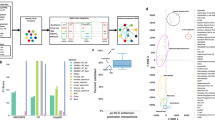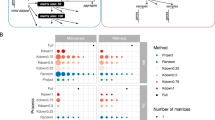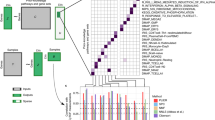Abstract
The rapid accumulation of microarray data translates into a need for methods to effectively integrate data generated with different platforms. Here we introduce an approach, 2nd-order expression analysis, that addresses this challenge by first extracting expression patterns as meta-information from each data set (1st-order expression analysis) and then analyzing them across multiple data sets. Using yeast as a model system, we demonstrate two distinct advantages of our approach: we can identify genes of the same function yet without coexpression patterns and we can elucidate the cooperativities between transcription factors for regulatory network reconstruction by overcoming a key obstacle, namely the quantification of activities of transcription factors. Experiments reported in the literature and performed in our lab support a significant number of our predictions.
This is a preview of subscription content, access via your institution
Access options
Subscribe to this journal
Receive 12 print issues and online access
$209.00 per year
only $17.42 per issue
Buy this article
- Purchase on Springer Link
- Instant access to full article PDF
Prices may be subject to local taxes which are calculated during checkout




Similar content being viewed by others
References
Edgar, R., Domrachev, M. & Lash, A.E. Gene Expression Omnibus: NCBI gene expression and hybridization array data repository. Nucleic Acids Res. 30, 207–210 (2002).
Gollub, J. et al. The Stanford Microarray Database: data access and quality assessment tools. Nucleic Acids Res. 31, 94–96 (2003).
Eisen, M.B., Spellman, P.T., Brown, P.O. & Botstein, D. Cluster analysis and display of genome-wide expression patterns. Proc. Natl. Acad. Sci. USA 95, 14863–14868 (1998).
Tavazoie, S., Hughes, J.D., Campbell, M.J., Cho, R.J. & Church, G.M. Systematic determination of genetic network architecture. Nat. Genet. 22, 281–285 (1999).
Zhou, X., Kao, M.C. & Wong, W.H. Transitive functional annotation by shortest-path analysis of gene expression data. Proc. Natl. Acad. Sci. USA 99, 12783–12788 (2002).
Rhodes, D.R. et al. Large-scale meta-analysis of cancer microarray data identifies common transcriptional profiles of neoplastic transformation and progression. Proc. Natl. Acad. Sci. USA 101, 9309–9314 (2004).
Gao, F., Foat, B.C. & Bussemaker, H.J. Defining transcriptional networks through integrative modeling of mRNA expression and transcription factor binding data. BMC Bioinformatics 5, 31 (2004).
Stuart, J.M., Segal, E., Koller, D. & Kim, S.K. A gene-coexpression network for global discovery of conserved genetic modules. Science 302, 249–255 (2003).
Horak, C.E. et al. Complex transcriptional circuitry at the G1/S transition in Saccharomyces cerevisiae. Genes Dev. 16, 3017–3033 (2002).
Martins, L.J. et al. Metalloregulation of FRE1 and FRE2 homologs in Saccharomyces cerevisiae. J. Biol. Chem. 273, 23716–23721 (1998).
Lee, T.I. et al. Transcriptional regulatory networks in Saccharomyces cerevisiae. Science 298, 799–804 (2002).
Ito, T. et al. A comprehensive two-hybrid analysis to explore the yeast protein interactome. Proc. Natl. Acad. Sci. USA 98, 4569–4574 (2001).
Uetz, P. et al. A comprehensive analysis of protein-protein interactions in Saccharomyces cerevisiae. Nature 403, 623–627 (2000).
Gavin, A.C. et al. Functional organization of the yeast proteome by systematic analysis of protein complexes. Nature 415, 141–147 (2002).
Ho, Y. et al. Systematic identification of protein complexes in Saccharomyces cerevisiae by mass spectrometry. Nature 415, 180–183 (2002).
Futcher, B. Transcriptional regulatory networks and the yeast cell cycle. Curr. Opin. Cell Biol. 14, 676–683 (2002).
Mountain, H.A., Bystrom, A.S. & Korch, C. The general amino acid control regulates MET4, which encodes a methionine-pathway-specific transcriptional activator of Saccharomyces cerevisiae. Mol. Microbiol. 7, 215–228 (1993).
Zhou, K., Brisco, P.R., Hinkkanen, A.E. & Kohlhaw, G.B. Structure of yeast regulatory gene LEU3 and evidence that LEU3 itself is under general amino acid control. Nucleic Acids Res. 15, 5261–5273 (1987).
Giaever, G. et al. Functional profiling of the Saccharomyces cerevisiae genome. Nature 418, 387–391 (2002).
Primig, M. et al. The core meiotic transcriptome in budding yeasts. Nat. Genet. 26, 415–423 (2000).
Chu, S. et al. The transcriptional program of sporulation in budding yeast. Science 282, 699–705 (1998).
Tanay, A., Sharan, R., Kupiec, M. & Shamir, R. Revealing modularity and organization in the yeast molecular network by integrated analysis of highly heterogeneous genomewide data. Proc. Natl. Acad. Sci. USA 101, 2981–2986 (2004).
Segal, E. et al. Module networks: identifying regulatory modules and their condition-specific regulators from gene expression data. Nat. Genet. 34, 166–176 (2003).
Bar-Joseph, Z. et al. Computational discovery of gene modules and regulatory networks. Nat. Biotechnol. 21, 1337–1342 (2003).
Natarajan, K. et al. Transcriptional profiling shows that Gcn4p is a master regulator of gene expression during amino acid starvation in yeast. Mol. Cell. Biol. 21, 4347–4368 (2001).
Roberts, C.J. et al. Signaling and circuitry of multiple MAPK pathways revealed by a matrix of global gene expression profiles. Science 287, 873–880 (2000).
Hughes, T.R. et al. Functional discovery via a compendium of expression profiles. Cell 102, 109–126 (2000).
Ashburner, M. et al. Gene ontology: tool for the unification of biology. The Gene Ontology Consortium. Nat. Genet. 25, 25–29 (2000).
Tseng, G. & Wong, W. A Method for Tight Clustering: with Application to Microarray. Proc. 2nd IEEE Computer Society Bioinformatics Conference, 396–397 (2003).
Peng, W.T., Krogan, N.J., Richards, D.P., Greenblatt, J.F. & Hughes, T.R. ESF1 is required for 18S rRNA synthesis in Saccharomyces cerevisiae. Nucleic Acids Res. 32, 1993–1999 (2004).
Acknowledgements
We thank Robert Gentleman for making his computer resources available for part of this project, Timothy Hughes for technical advice and Michelle Arbeitman for sharing her lab space. We also thank two anonymous reviewers for their helpful comments. The work of X.J.Z. was supported by the National Science Foundation grant DMS0090166 to W.H.W., the Faculty Setup Grant from USC and the National Institutes of Health (NIH) grant R01GM067243 to Simon Tavaré. The work of M.-C.J.K was supported by a Howard Hughes Pre-doctoral Fellowship. The work of H.H. was supported by the NIH grant P20CA96470 to W.H.W. and the Faculty Setup Grant from UC Berkeley. The work of W.H.W. was supported by the NIH grant R01HG02341.
Author information
Authors and Affiliations
Corresponding authors
Ethics declarations
Competing interests
The authors declare no competing financial interests.
Supplementary information
Supplementary Table 1
Functional prediction of unknown yeast genes (PDF 18 kb)
Supplementary Table 2
60 derived transcription modules (PDF 15 kb)
Rights and permissions
About this article
Cite this article
Zhou, X., Kao, MC., Huang, H. et al. Functional annotation and network reconstruction through cross-platform integration of microarray data. Nat Biotechnol 23, 238–243 (2005). https://doi.org/10.1038/nbt1058
Received:
Accepted:
Published:
Issue Date:
DOI: https://doi.org/10.1038/nbt1058
This article is cited by
-
Systematic noise degrades gene co-expression signals but can be corrected
BMC Bioinformatics (2015)
-
A formal concept analysis approach to consensus clustering of multi-experiment expression data
BMC Bioinformatics (2014)
-
Transcriptional regulatory network analysis of the over-expressed genes in adipose tissue
Genes & Genomics (2014)
-
Interval Graph Limits
Annals of Combinatorics (2013)
-
SignatureClust: a tool for landmark gene-guided clustering
Soft Computing (2012)



